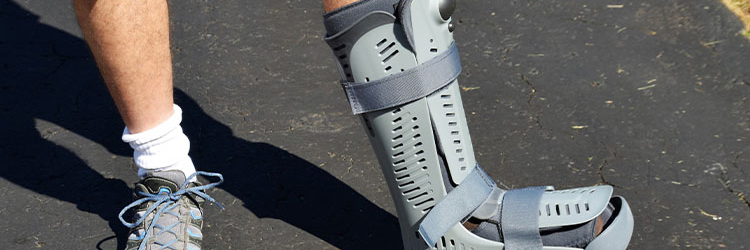What is an ankle sprain?
An ankle sprain is a common injury that occurs when the ligaments that connect the bones in the ankle joint are stretched or torn. Ankle sprains can range from mild to severe, depending on the extent of ligament damage.
The most common type of ankle sprain is an inversion sprain, which occurs when the foot rolls inward, causing damage to the ligaments on the outer side of the ankle. Eversion sprains, which occur when the foot rolls outward, are less common but can also cause ligament damage on the inner side of the ankle.
Ankle sprains can cause pain, swelling, bruising, and difficulty walking or bearing weight on the affected foot. Treatment for ankle sprains may include rest, ice, compression, and elevation (RICE), Anti-inflammatory medication and/or injections as well as physical therapy exercises to improve strength and range of motion. Severe ankle sprains may require immobilization in a cast or boot, and in some cases, surgery may be necessary to repair or reconstruct the damaged ligaments. Oftentimes MRI imaging is required to assess the integrity of the ligament and surrounding ankle joint structures. Come to PS Foot and Ankle for a full evaluation if you are suffering from an ankle sprain.
What is an ankle fracture?
An ankle fracture is a break in one or more of the bones that make up the ankle joint, including the tibia, fibula, and talus. Ankle fractures can range in severity from a small crack in one of the bones to a complete break that causes the bones to become displaced.
Ankle fractures can be caused by a variety of factors, including falls, twisting injuries, and direct trauma to the ankle. Symptoms of an ankle fracture may include pain, swelling, bruising, and difficulty bearing weight on the affected foot. X-rays and sometimes CT scans are commonly performed to assess degrees of the fracture.
Treatment for ankle fractures depends on the severity and location of the fracture. For mild fractures that are minimally displaced, may require immobilization for 6-8 weeks along with rest, ice, compression, and elevation (RICE) may be sufficient to manage symptoms while the bone heals. Depending on the type of fracture (increased angulation or displacement of fracture fragment), along with patient age, and activity level surgery may be the better option to appropriately realign and stabilize the broken bones for a quicker return to normal activity. The use of hardware ensures appropriate integrity and alignment of bone healing to allow for normal ambulation and ankle joint function. An ankle Open Reduction Internal Fixation procedure maybe most appropriate pending the type of fracture. Physical therapy exercises are always recommended to ensure optimal range of motion, strength and balance after suffering an ankle fracture. Make an appointment for PS Foot and Ankle in Bridgewater, New Jersey (near Somerville) for a full evaluation of your ankle fracture, including onsite X-rays and evaluation, our doctors will provide essential information about your injury to ensure you can get back to your regular lifestyle as soon as possible.






